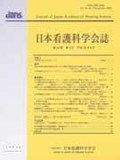Japanese
English
- 販売していません
- Abstract 文献概要
- 参考文献 Reference
要旨
目的:本研究は「2型糖尿病患者の糖尿病イメージを見るための質問紙」を作成し,その有用性を糖尿病イメージと糖尿病コントロールの関係性から明らかにすることで検討した.
方法:質的に導いた「2型糖尿病患者の糖尿病イメージ」から質問紙の原案を作成し,3施設の2型糖尿病患者を対象に調査(分析対象167名)を実施した.調査項目は,質問紙原案,糖尿病コントロール(代謝コントロール指標:HbA1c,QOL指標:糖尿病問題領域質問票(PAID),セルフケア行動指標:慢性病者のセルフケア能力を査定する質問紙(SCAQ))とした.分析は,探索的因子分析を行い,因子得点をもとにCluster分析で2型糖尿病患者を分類した.分類されたクラスタ別に糖尿病コントロールとの関係を検定比較した.
結果と考察:28項目7因子構造から成る「2型糖尿病患者の糖尿病イメージを見るための質問紙」を作成した.糖尿病イメージ7因子により対象は3つのクラスタに分類された.糖尿病コントロールにおいて,各クラスタとHbA1cに有意な関係性は認められなかったが,PAIDおよびSCAQ得点において各クラスタに差が見られ,本質問紙により糖尿病イメージを把握することの有用性が示された.
Abstract
Objectives: This study was carried out to evaluate the usefulness of a questionnaire created for the purpose of understanding type 2 diabetes patients' perception of their disease based on the relation between patient perception and diabetes control.
Methods: We created a questionnaire based on quantitative data on type 2 diabetes patients acquired from a previous study and carried out a self-administered questionnaire survey targeting type 2 diabetes patients hospitalized at three medical facilities(number of subjects for the analysis: 167). In addition to the items included in the questionnaire draft, we surveyed subjects on items regarding diabetic control; namely, Metabolic control index utilizing HbA1c; QOL index utilizing Problem Areas In Diabetes Survey(PAID); and Chronic invalids self-care behavior index utilizing Self-Care Agency Questionnaire(SCAQ). We applied exploratory factor analysis to determine factor structure. We classified type 2 diabetes patients through cluster analysis based on the factor scores. We conducted comparative analysis on the relationship between classified clusters and diabetic control.
Conclusions and Discussion: We created a questionnaire for the purpose of understanding type 2 diabetes patients' perception of their disease. The questionnaire consisted of 28 items and seven factors. Subjects were classified into three clusters depending on the seven factors of their perceptions of diabetes. In diabetic control, there was no significant relationship between each cluster and HbA1c; however, there were differences in PAID and SCAQ scores among clusters, which indicated the usefulness of the questionnaire created for this study in understanding patients' perception of the disease.
Copyright © 2013, Japan Academy of Nursing Science. All rights reserved.


